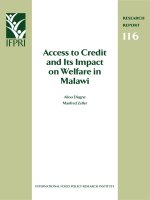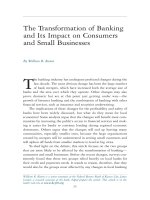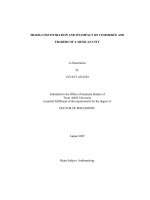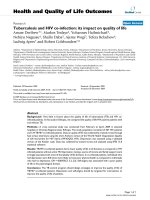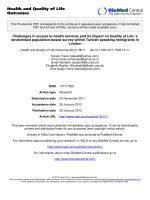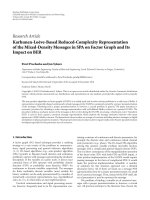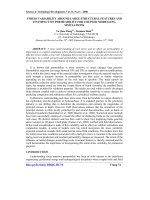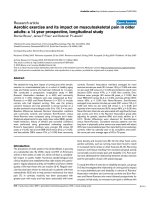Trade-concentration and its impact on commerce and traders of a Mexican city
Bạn đang xem bản rút gọn của tài liệu. Xem và tải ngay bản đầy đủ của tài liệu tại đây (1.85 MB, 232 trang )
TRADE-CONCENTRATION AND ITS IMPACT ON COMMERCE AND
TRADERS OF A MEXICAN CITY
A Dissertation
by
JAYANT ANAND
Submitted to the Office of Graduate Studies of
Texas A&M University
in partial fulfillment of the requirements for the degree of
DOCTOR OF PHILOSOPHY
August 2007
Major Subject: Anthropology
UMI Number: 3281019
3281019
2007
UMI Microform
Copyright
All rights reserved. This microform edition is protected against
unauthorized copying under Title 17, United States Code.
ProQuest Information and Learning Company
300 North Zeeb Road
P.O. Box 1346
Ann Arbor, MI 48106-1346
by ProQuest Information and Learning Company.
TRADE-CONCENTRATION AND ITS IMPACT ON COMMERCE AND
TRADERS OF A MEXICAN CITY
A Dissertation
by
JAYANT ANAND
Submitted to the Office of Graduate Studies of
Texas A&M University
in partial fulfillment of the requirements for the degree of
DOCTOR OF PHILOSOPHY
Approved by:
Chair of Committee, Norbert Dannhaeuser
Committee Members, Michael S. Alvard
Cynthia A. Werner
Cecilia Giusti
Head of Department, David L. Carlson
August 2007
Major Subject: Anthropology
iii
ABSTRACT
Trade-Concentration and Its Impact on Commerce and Traders of a Mexican City.
(August 2007)
Jayant Anand, B.Sc., University of Mumbai;
M.M.S., University of Mumbai;
M.A., University of Mumbai
Chair of Advisory Committee: Dr. Norbert Dannhaeuser
This dissertation evaluates the changes in food retailing patterns in the face of open-
market trends in a medium sized city (Citlalicalli) in central Mexico. This evaluation is
carried out using the model of retail trade-concentration. The following questions are
addressed: whether trade-concentration had occurred in the field-site; if yes, what were
the causes; and, what were the effects of retail concentration on preexisting food
retailers.
The fieldwork for this study was conducted over a 14 month period (May 2005 and
June 2006). Empirical data were collected using three surveys, over 25 interviews, and
several hours of participant observations. Along with these primary data, secondary data
from official records were also collected. The survey data were analyzed using non-
parametric tests.
The findings from the study revealed that trade-concentration is proceeding in
Citlalicalli and the recent spread of large stores in the region has been encouraged by
free-trade policies adopted by Mexico since the mid-1980s. Trade-concentration in the
iv
Altepetl metropolitan area has also been aided by the positive behavior that consumers
show towards large retail chains.
Contrary to popular belief, the impact of retail concentration on preexisting small
retailers in Citlalicalli has been minimal. Partly traditions and partly the nearness of a
particular store explain the continued patronization of small stores by consumers. The
product category and income of consumers also influence their purchase decisions. This
research shows that competition in food retailing in developing countries is between
same size and same type retailers. Small retailers are not always in direct competition
with modern retailers as they serve different sections of the society.
Retail development is a part of urban development and, therefore, has direct
implications for the quality of life in cities. In emerging economies, cities like Citlalicalli
have vibrant town centers which provide convenient access to offices, shops, and
entertainment areas for its citizens. This study concludes that appropriate policy
measures can ensure the coexistence of large and small retailers in developing countries
and, thereby, the continued vitality of city centers.
v
DEDICATION
I dedicate this work to my parents, sister, and wife who make my life complete.
vi
ACKNOWLEDGMENTS
There have been numerous people who have helped me reach this stage in my life. It
would be impossible to acknowledge them all by name here. However, there are a few
who have been extremely important. First and foremost, I would like to thank my
parents for supporting me through the years and teaching me the importance of
education. My sister, Dr. Smriti Anand, who took care of me like her own child,
supported me emotionally, as well as financially, through my graduate student life in the
US. The last three years as a graduate student were made comfortable by my friend, and
now my wife, who stood by me during the many times of stress and frustrations.
My roommates, Drs. Ketan Patel, Abhay Kumar Singh, Arjun Sudarsan, and Sanjeev
Saraf, made the last five years in the US enjoyable. This dissertation would not have
been possible without the hours of discussions with my friends, Iftekhar Ahmed,
Elizabeth Angélica Cantú-Botello, Kumok Nam, Yogita Sharma, and Zeba Imam. These
friendships have made my graduate life most memorable.
Fellow graduate students Dr. Eric J. Bartelink, Dr. Jason Wiersema, Dr. Cassady
Yoder, Allen Gillespie, Dante Bartoli, and Maria Parks made my initial adjustments to
being a graduate student in America smooth. I would not have been able to conduct my
fieldwork in Mexico without the help that I received from my Spanish instructor Mtro.
José Antonio Caraballo Rivera and fellow graduate students Christopher and Margie
Sparks.
I would like to thank my colleagues in Mexico, Dr. Rocío Moreno, Dr. Robyn
Johnson, Dr. Fernando Buendía, Dr. Roberto Solano, and Dr. Felipe Burgos for their
vii
support. I would not have been able to make it to Mexico on time but for my friend Ms.
Alethia Cobos. I would like to thank my friend Yesenia for teaching me to live and work
in Mexico. I cannot thank enough Dr. K. V. Sudhakar and Dr. Román López-Villicaña
and their families who took me into their lives as one of their own. I would also like to
thank Sofía for helping me with translating my questionnaires and conducting the initial
surveys. My data collection for this research would not have been possible but for my
students in Mexico.
I would specially like to thank Dr. Enrique Reig, Prof. Kristiano Raccanello, and Ms.
Carolyn Grebe with whom I enjoyed working on various projects. Special thanks are
also due to my friends Citlali, Ernesto, and Liliana who continued to extend their support
to me as I was writing my dissertation. Most of all, I would like to acknowledge that this
work would not have been possible but for the trust that my informants in Mexico placed
in me.
I could not reach this stage in my academic career without the advice and support
offered by Dr. Rabindra Ray at the Delhi School of Economics, and Drs. David L.
Carlson, D. Bruce Dickson, Sylvia Grider, Vaughn Bryant, Sharon Gursky, Elizabeth
Tebeaux, Marlyn May, and Alex McIntosh at Texas A&M University. I would also like
to thank my committee members who have guided me in my dissertation writing and
been extremely patient in the process, especially Dr. Cynthia Werner who spent long
hours reviewing my multiple drafts despite her busy schedule. I would like to specially
thank Dr. Michael S. Alvard who not only advised me on my research, but also on
teaching, and life in the academe.
viii
Over the years, there have been many members in the staff of the Department of
Anthropology who have helped on numerous occasions. Their commitment to making
the life of students easier is unmatched. I would specially like to thank Ms. Rebekah
Luza, Ms. Cynthia Hurt, Ms. Leslie Riley, Ms. Melissa Kennedy, Ms. Ekeata Iredia, Ms.
Adeala Adesina, and Ms. Mónica Ramos. Many members of the staff have retired or
moved to other positions since I first joined the department in August 2002. I would like
to take this opportunity to thank them too. I would like to thank Mr. Don DeLucia, Ms.
Olga Martinez, Ms. Karen Taylor, and Ms. Angie Shafer.
Last, but not the least, I would like to thank Dr. Norbert Dannhaeuser, my advisor
and mentor. Without his initiative, I would never have been able to come to the United
States to pursue my doctoral studies. I owe a lot to Dr. Dannhaeuser and his wife Mrs.
Shirley Dannhaeuser who supported me emotionally and treated me as their own son.
ix
TABLE OF CONTENTS
Page
ABSTRACT iii
DEDICATION v
ACKNOWLEDGMENTS vi
TABLE OF CONTENTS ix
LIST OF FIGURES xii
LIST OF TABLES xiii
GLOSSARY xiv
CHAPTER
I INTRODUCTION 1
Theoretical Considerations 5
The Trade-Concentration Model 12
A Brief History and Description of the Field-Site 18
Summary of Chapters 31
II METHODOLOGY 33
Selection of the Field-Site 33
Surveys, Interviews, and Participant Observations 35
Conducting Fieldwork 43
III MARKETS AND SUPERMARKETS 50
Previous Studies of the Economy and Markets 50
Classification of Retailers 67
The Market Area of Citlalicalli 71
x
CHAPTER Page
IV TRADE-CONCENTRATION IN CITLALICALLI 84
Trade-Concentration in Latin America 84
Trade-Concentration in Mexico 86
Trade-Concentration in Citlalicalli 90
V CAUSES OF RETAIL CONCENTRATION 100
Conditions that Encourage Retail Trade-Concentration 100
Factors that Impede Retail Trade-Concentration 104
Questions to be Evaluated 106
Conditions in Citlalicalli 108
Summary of Findings 128
VI EFFECTS OF RETAIL CONCENTRATION 131
A Theoretical Review of the
Effects of Retail Trade-Concentration 131
Case Histories of Typical Retailers 135
Evaluating the Effects of Retail
Trade-Concentration in Citlalicalli 154
Summary of Findings 166
VII CONCLUSIONS 168
Salient Findings of this Study 168
Contributions of this Study 172
Recommendations for Sustainable Retail Development 174
Suggestions for Future Research 175
REFERENCES CITED 177
APPENDIX A 195
APPENDIX B 200
APPENDIX C 201
APPENDIX D 203
APPENDIX E 208
xi
Page
APPENDIX F 212
VITA 217
xii
LIST OF FIGURES
FIGURE Page
1.1 Location of Citlalicalli in Mexico 21
1.2 Map of Citlalicalli, Heultiuhtli, and Altepetl 22
3.1 Street Map of Citlalicalli in 2005 72
3.2 Retail Survey Area 73
3.3 Layout of the Municipal Marketplace (Mercado Municipal)
of Citlalicalli in 2005 76
3.4 Aerial Picture of Citlalicalli 77
3.5 Main Street of Citlalicalli 78
3.6 Portales during the City Fair (Feria) 79
5.1 Income Distribution Across Neighborhoods in Citlalicalli……… 115
5.2 Income Distribution Across Neighborhoods in Hueltiuhtli 116
5.3 Income Distribution Across Neighborhoods in Altepetl 117
6.1 Mini-Bodega on Calle Principal of Citlalicalli 137
6.2 Traditional Chicken Store in the
Municipal Marketplace of Citlalicalli 138
6.3 Traditional Grocery Store in the
Municipal Marketplace of Citlallicalli 139
xiii
LIST OF TABLES
TABLE Page
2.1 Distribution of Income Groups in the Data 48
3.1 Store Categories Included in the Retail Survey 80
4.1 Supermarket Proliferation in Latin America 85
4.2 Growth of Select Large Retail Chains in Mexico (1993-2001) 89
4.3 Distribution of Wal-Mart Stores in Mexico as of March 31, 2007 92
4.4 Distribution of Comercial Mexicana Stores in Mexico in 2005 93
4.5 Distribution of Grupo Gigante Stores in Mexico in 2005 95
4.6 Distribution of Chedraui Stores in Mexico in 2006 97
5.1 Population Trends for Altepetl Urban Agglomerate (1950-2000) 113
5.2 Employment Trends for Altepetl Urban Agglomerate (1980-2000). 115
5.3 Car and Refrigeration Ownership in the Market Area in 2000 119
5.4 Results of Kruskal-Wallis Test to Determine Attitude
Differences Based on Location of Consumer’s Residence 122
6.1 Food Retailers by Category in Citlalicalli (2005) 141
6.2 Food Retailers Surveyd in 2005-2006 140
6.3 Consumer Buying Preferences 155
6.4 Consumer Buying Preferences Disaggregated by Income 157
6.5 Percentage of Respondents Who Bought at the
Following Large Stores 158
6.6 Comparative Prices of Select Products at Different Store Types 165
xiv
GLOSSARY
Abarrotero General grocer. Abarrotes means packed goods.
Agua de Jamaica Sweet drink made by soaking the dried petals of the hibiscus
(Jamaica) flower in water.
FDI Foreign Direct Investment.
INEGI Acronym for Instituto Nacional de Estadística Geografía e
Informática. It is the organization that collects and maintains the
socio-economic and demographic statistical data of Mexico.
MERCOSUR Refers to the Spanish acroym Mercado Común del Sur. Also
known as MERCOSUL (Comum do Sul) in Portuguese. Is the
Southern Common Market between Brazil, Argentina, Uruguay,
Venezuela, and Paraguay.
NAFTA North American Free Trade Agreement. Referred to in Spanish by
the acronym TCLAN (Tratado de Libre Comercio de América del
Norte).
Nte. Abbreviation for norte, meaning north in Spanish.
Ote. Abbreviation for oriente, meaning east in Spanish.
Portales The arches in the main building of the zócalo that act as door-
ways to the restaurants located in the building. Sometimes
referred to as los arcos.
Pte. Abbreviation for poniente, meaning west in Spanish.
Pueblos Townships
Sur Meaning south in Spanish.
Tianguis Temporary stalls of itinerant vendors in Mexico.
TNC Transnational Corporation.
Zócalo Town square that houses the municipal offices and the city
church. Usually has restaurants and a park.
1
CHAPTER I
INTRODUCTION
The objective of this dissertation is to evaluate the changes in retailing patterns in the
face of free-trade trends in a medium sized city (Citlalicalli
1
) in central Mexico. This
evaluation is carried out using the model of retail trade-concentration. More specifically,
this study provides the background for the concept of retail trade-concentration and its
application to emerging economies. Then, the status of trade-concentration in Citlalicalli
is evaluated. Once the presence of retail trade-concentration is established, causes of its
occurrence and its effects on the retail structure of Citlalicalli are addressed. Finally, a
brief qualitative forecast of the future of retailing in Citlalicalli is presented and
implications for emerging economies are addressed.
We as humans are first consumers, before we take on other roles in the society. Most
of us provide for ourselves and our families, and in the process become an integral part
of exchange. Even in societies where modern malls and supermarkets did not exist, food
exchange of food was not uncommon. What makes our post-industrial world different
from that of less complex societies is trade and commerce. Most urban dwellers today
are not food producers. Most people, living in the modern world, do not produce
consumer durables. This necessitates the buying of food and other goods from producers
(indirectly, through the distribution channel); thus, making us the last link in the
distribution chain.
This dissertation follows the style of American Anthropologist.
1
Citlalicalli is the pseudonym for the field-site. See Chapter II, Methodology, for details.
2
Distribution channels that allow us to acquire goods for consumption are something
that remain invisible to most consumers. As consumers in the post-industrial society, our
most common point of interaction with market channels is the retail outlet where we
buy. The position of the retailer is, therefore, very important as it brings the consumer in
contact with the producer, albeit indirectly. The upward linkages that the retailer has in
the market channel are also of great importance to us as consumers. Reliable links with
wholesalers allow the retailer to offer the best value to the consumers for the goods
purchased. Therefore, the distribution channel, especially in modern retailing, is an
important aspect to study.
The industrial revolution in Europe changed the way goods are produced, distributed,
and consumed. For instance, cotton grown in India and transformed to mass produced
textiles in Manchester (England) made their way to back to the markets in the Indian
subcontinent through the East India Company. Cross-continental trade thus changed
qualitatively in the process; colonizers started using colonies not only as the source of
raw material but also as markets for finished products. This kind of trade spread to most
parts of the world through trade between the colonial masters in Europe and their
colonies in Asia, Latin America, and Africa. In the post-colonial world, this process
continued for many decades after the former colonies gained independence. Newly
independent countries, gradually, tried to industrialize and modify the conditions of trade
that existed in colonial times.
3
The second-half of the twentieth century, when many colonies gained
independence,
2
marked a shift in global trade. In order to become self-reliant and
competitive in the global market, newly independent countries embarked on
industrialization projects. The growth of industrial towns brought in rapid urbanization
in many developing countries. And urbanization in turn brought about changes in the
way goods were distributed to reach the consumers.
In the United States, the spread of large-format retail institutions started in the late-
19
th
Century and intensified in the 1950s. The retail revolution that started in the US in
the 1860s with the department store was accompanied by vertical integration of supply
channels (Bucklin 1972:55-60). A similar change happened in the developed countries
of Europe. The proliferation of large retailers brought with it changes in the distribution
channels. Large retailers, seeking bigger urban markets, reduced transaction costs by
vertically integrating the market channels. Today, even the developing countries of Asia,
Latin America, and Africa are experiencing a proliferation of large retail chains.
The adoption of the free-trade agenda (reduction in barriers for trade and
investments) by many developing areas of Asia and Latin America accelerated the
spread of large retail chains in these countries. For instance, the formation of the
Southern Common Market (MERCOSUR) in South America in 1991, the joining of
Mexico to NAFTA (North American Free Trade Agreement) in 1994, and the
liberalization of India in the early 1990s, have encouraged international trade and foreign
direct investments (including investments in the retail sector) in these countries. These
2
The first phase of decolonization started in the new world in the early 19
th
Century.
4
free-trade policies have accelerated the influx of international retail chains into these
developing countries (e.g. Carrefour in Argentina, and Wal-Mart in Mexico and India).
Traditionally, anthropologists have ignored modern retailing despite an overall shift
in interest to the economy of modern complex societies (Garsten and Lindh de Montoya
2004a:1). Until the 1970s, most economic anthropological studies avoided societies
where “market exchange transactions predominate” (Green 1976:531). Since the 1970s,
anthropologists have shifted their attention to studying economic and social problems in
newly formed (post-colonial) nation-states (Wilk 1996:14). Many of these studies
followed Polanyi’s three-fold classification of the economy: reciprocity, redistribution,
and exchange (Schneider 1989:7; Wilk 1996:7). During the 1970s and 80s, many
economic anthropologists shifted their focus to what is today known as the field of
development anthropology, but again focused largely on peasants and peasant markets
(Wilk 1996:20-21). In the last two decades, anthropologists have made significant
contributions to understanding the development process (Dannhaeuser and Werner
2003b), entrepreneurship (Greenfield and Strickon 1986), and consumption (Carrier and
Heyman 1997; Miller 1995; Ngai 2003). Most recently, economic anthropologists have
extended their domain of study to include modern market systems, marketing, and
financial markets (e.g. see Garsten and Lindh de Montoya 2004b). In spite of this,
anthropological studies on modern retail systems are wanting (for exceptions see
Applbaum 2004; Dannhaeuser 1977, 1989, 1996, 2004; Matejowsky 2001; Price 1967;
Sherry, et al. 2001).
5
Modern retailing has been extensively studied by scholars in the field of business,
including retail markets in developing countries. Recent articles on modern retailing
have been dominated by studies on the rise of supermarkets in developing countries
(Cadilhon, et al. 2006; Coleman 2003; Reardon and Berdegué 2002; Reardon and
Swinnen 2004; Reardon, et al. 2003; Schwentesius and Gόmez 2002; Traill 2006). These
articles examine the proliferation of supermarkets and its impact on the retail market
channels in developing countries. Since they focus on the national level, they lack the
micro-level detail that is characteristic of anthropological studies.
This dissertation attempts to bridge the gap between the micro-approach of
anthropology and macro-approach of business in the study of modern retailing. This
study presents a micro-level understanding of structural changes in modern food
retailing systems in emerging economies because household expenditure on food in low
and middle income countries is over 50% (Gingrich 1999). In other words, food retailing
is the most important category of the retail sector in developing countries. The following
areas are addressed to evaluate structural developments in retailing: (1) Has trade-
concentration occurred in Citlalicalli? (2) If trade-concentration has taken place, what
are the causes of this retail development? (3) How have they affected traditional retailers
in this market? (4) What changes can we expect in the retail structure in future?
Theoretical Considerations
This dissertation helps to relate retail developments to the modernization process and
development theories. In this study I make a distinction between modern and traditional
retailers. These categories, as used in this work, are defined in Chapter III and the
6
distinction is explored in detail in Chapter VI through case histories of select retailers.
Given the distinction between modern and traditional, it is pertinent to understand how
modernity and development are presented in the scholarly literature and how they are
linked to retail trade.
Scholars of modernity and development have debated the interconnectedness of the
two concepts (see e.g. Grosfoguel 2000; Portes 1973). The anthropological critique of
development comes from two distinct quarters (Cohen and Dannhaeuser 2002:xi-xii). In
the first group are anthropologists who have come to call themselves, and being called,
practicing anthropologists. These anthropologists usually analyze their projects
objectively to present the positive and negative effects of their study. In the other group
are critical anthropologists who primarily critique development as an idea rather than as
a project. It is this second group that generally views development as being separate
from modernity. Such scholars do not accept development as a shift from the
“traditional” to the “modern” (Escobar 1991: 659).
3
Development, for such scholars, is a
concept created by the West to exploit peripheral countries by first defining the term and
them labeling countries as developed and underdeveloped (Escobar 1995). Some of
these scholars view the concept of “development” as a replacement for “imperialism”
(Olivier de Sardan 2005:6). Unfortunately, such a critique is akin to throwing “the baby
out with the bath water” (Cohen and Dannhaeuser 2002:xii).
In this study, I view modernization and development as interrelated concepts, though
not entirely like early scholars of development who saw traditions as being detrimental
3
The terms “traditional” and “modern” as used in this study are defined in Chapter III.
7
to development (Gilman 2002). I treat development as the process of moving away from
what is “traditional” to what is “modern.” As Bendix (1967: 330-331) argues,
“modernization… refers to a type of social change since the eighteenth century, which
consists in the economic or political advance of some pioneering society and subsequent
changes in follower societies.” The development process, therefore, entails cultural
change (Dannhaeuser and Werner 2003a:xv). Accordingly, in this dissertation, I treat
retail development as a shift from traditional retailing to modern retailing.
4
One of the factors that influence economic development is globalization.
Globalization involves the flow of capital, labor, and goods and services across
geographical and political boundaries. Jagdish Bhagwati (2004) argues that globalization
brings about economic prosperity in underdeveloped countries. As Appadurai (2000:5)
observes, we live in “a world of flows.” The forces of globalization bring with it goods,
ideas, and images across national boundaries. To understand the process of trade-
concentration, and the consequent retail restructuring, one has to take into account the
phenomenon of globalization. The proliferation of supermarkets into nascent retail
markets often introduces a new array of products and a new set of perceptions about
price and quality of goods and services among the consumers. This new outlook will
also bring about a shift in consumer buying behavior.
In the context of free-trade and globalization, the dependency theory became popular
amongst policy markers in Latin America in the 1960s (Valenzuela and Valenzuela
1978:536). Dependency theory explains the economic development path followed by
4
In the case of retailing, the United States could be considered as the ‘pioneering society’.
8
most Latin American countries from a vantage point opposing the modernization theory.
Modernization theorists assumed that Latin American countries were “below the
threshold of modernity” and their traditional patterns of action was a cause of their
underdevelopment (Valenzuela and Valenzuela 1978:537-538). Alternatively,
dependency theorists explained the underdevelopment of Latin American countries as a
result of “unequal terms of trade between exporters of raw materials and exporters of
manufactured goods” (Valenzuela and Valenzuela 1978:543). This led to many Latin
American countries (most notably Argentina, Brazil, and Mexico) to adopt import
substitution industrialization (ISI) (Valenzuela and Valenzuela 1978:548-549). The ISI
driven economic development began in these countries in the 1930s and intensified in
the 1950s and 1960s (Giusti Hundskopf 2001:51). The failure of the ISI model led many
Latin American countries to adopt the Free Trade Industrialization Model since the
1980s (Giusti Hundskopf 2001:53-54). This phase has encouraged the influx of foreign
investments and is termed as the period of “transnational capitalism” by dependency
scholars (Valenzuela and Valenzuela 1978:547).
Building on the dependency theory, Wallerstein (1974:390) defines a world-system
as a “a unit with a single division of labor and multiple cultural systems.” Wallerstein
(1974:390) explains that world-systems can be logically differentiated as world-empires
or world-economies. He argues that world-empires
5
have a common political system,
whereas world-economies do not have this feature. Thus, he argues, the present-day
world-system is the capitalist world-economy. In other words, a world-economy
5
Wallerstien considers pre-modern civilizations such as China, Egypt, and Rome as world-empires. The
colonial empires of Britain and France in the nineteenth century do not qualify to be world-empires.
9
functions as a common economic entity with dependencies due to the division of labor
between the wealthy core and the poor peripheral countries.
In our interconnected world, transnational forces wield a great deal of influence on
national markets. The capitalist world-economy internationalizes the division of labor
and controls the shifting roles of the core and periphery nations (Sklair 1999:149). As
Chase-Dunn (1999:189) argues, “information technology has created a context in which
the global market, rather than separate national markets, is the relevant arena for
economic competition.” Transnational corporations (TNCs) are on the forefront of such
changes. TNCs globalize capital, production, and mass-media (Sklair 1999: 146). This
dominance has led to economic upheavals in developing countries. As Brachet-Marquez
(1992:92) observes, in the early 1990s Mexico witnessed “massive capital flight,
towering foreign debt, record unemployment, three-digit inflation, rampant de-
industrialization, and a ruthless monetary stabilization program that has ‘liberalized’
everything but wages and salaries.” It is also undeniable that TNCs, by way of foreign
direct investments (FDIs), have stimulated growth in many developing countries around
the world (Bhagwati 2004; Inglehart and Baker 2000:21). The role of TNCs in economic
development is also seen in the retail sector.
Ultimately the changes entailed in modernity are brought about by individuals.
Therefore, in the case of retailing I am concerned with individual entrepreneurs. The
assumption here is that, it is through the modern outlook of such individuals that the
traditional market will modernize itself. Hunt (1971: 890-91, 893) in his study of Indian
industrialists identifies the following characteristics of individual modernity: (1)
10
achievement motivation (derived from David McClelland’s idea of achievement
motivation), and (2) capacity of sustaining social relationships.
6
Hunt argues that more
motivated individuals will plan ahead, take moderate risks, and seek avenues to expand
their business environment. Such individuals will be more inclined to build networks
through associations. The individual’s ability to sustain these networks will depend on
the level of “interpersonal trust, social efficacy, openness to new experience, tolerance to
conflict and awareness of opportunity” (Hunt 1971:893).
David McClelland (1967:34) argues that “external resources (i.e., markets, minerals,
trade routes, or factories)” alone cannot lead to economic development unless there
exists an “entrepreneurial spirit that exploits those resources.” The motivation for
entrepreneurs, according to McClelland (1967:35), is not just profit but is in fact “a
strong desire for achievement, for doing a good job.” In other words, the definitions of
success will depend on individuals. Further, McClelland (1967:44-47) identifies the
following characteristics of achievers: desire to take on responsibilities and find
solutions to problems; set moderate achievement goals and take “calculated risks”; and,
seek concrete feedback on his/her work. Thus, the focus of economic development is the
entrepreneur.
In early twentieth century, Joseph Schumpeter defined an entrepreneur as an
innovator (Marsh and Mannari 1986:20). Following Barnett (1953:7), for the purposes of
this study, an innovation is “any thought, behavior, or thing that is new because it is
qualitatively different from existing forms.” In this scheme of things, innovations are
6
Recent studies in socio-cultural anthropology have also explored the idea of social relations (e.g. see
Smart 1993).
